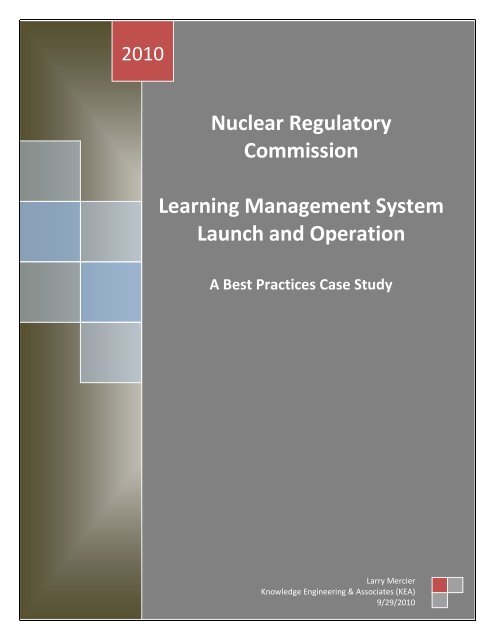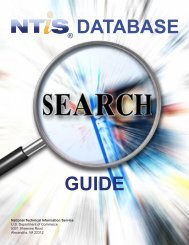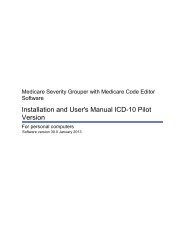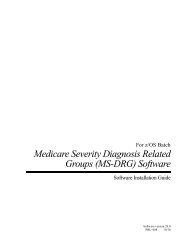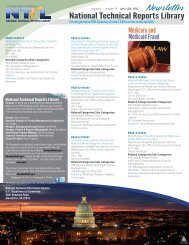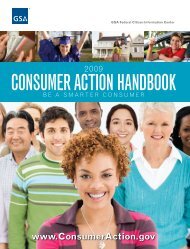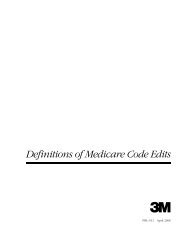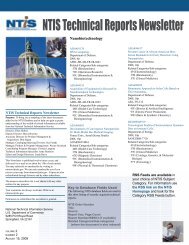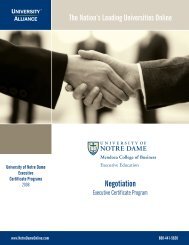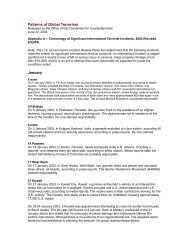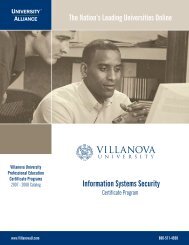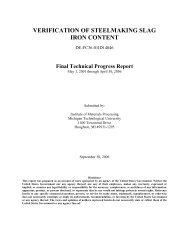Nuclear Regulatory Commission Learning Management System ...
Nuclear Regulatory Commission Learning Management System ...
Nuclear Regulatory Commission Learning Management System ...
Create successful ePaper yourself
Turn your PDF publications into a flip-book with our unique Google optimized e-Paper software.
2010<br />
<strong>Nuclear</strong> <strong>Regulatory</strong><br />
<strong>Commission</strong><br />
<strong>Learning</strong> <strong>Management</strong> <strong>System</strong><br />
Launch and Operation<br />
A Best Practices Case Study<br />
Larry Mercier<br />
Knowledge Engineering & Associates (KEA)<br />
9/29/2010
NRC Launch and Operation of a<br />
<strong>Learning</strong> <strong>Management</strong> <strong>System</strong><br />
A Best Practices Case Study<br />
Overview<br />
This paper describes how the <strong>Nuclear</strong> <strong>Regulatory</strong> <strong>Commission</strong> achieved high levels of end user satisfaction with<br />
their <strong>Learning</strong> <strong>Management</strong> <strong>System</strong> (LMS), while vastly improving their return on investment. Typically,<br />
customer satisfaction with LMS and talent management systems is very low (see Figure 1.) However, in a few<br />
short months, the NRC was able to achieve significant improvements in satisfaction, and has set the stage to<br />
achieve much higher levels of satisfaction in the future, and greater use of their LMS/talent management system.<br />
Over the past couple years the NRC has experienced major changes in its mission requirements, resulting in<br />
dramatic new demands on learning and development. To meet this challenge the NRC drastically improved the<br />
delivery of training and development services by repositioning and upgrading its Plateau LMS and related<br />
learning processes. This has resulted in a 112% improvement in LMS customer satisfaction key indicators with<br />
the LMS and related services and achieved a $2.2M annual savings in FTE hours by improving operational<br />
efficiency, with an ROI of 470% when<br />
compared to the improvement costs.<br />
This was accomplished by applying the<br />
principals of strong customer focus,<br />
systematic communications, best<br />
practices in LMS implementation<br />
planning, business process<br />
reengineering, improving help services<br />
and right sizing staff support.<br />
About the NRC<br />
The U.S. <strong>Nuclear</strong> <strong>Regulatory</strong><br />
<strong>Commission</strong> (NRC) is responsible for<br />
regulating domestic activities related to<br />
radiation protection and nuclear safety<br />
for nuclear facilities and for promoting<br />
Talent <strong>Management</strong> Software Customer Satisfaction<br />
NRC LMS End User Satisfaction<br />
Customer Satisfaction with LMS and<br />
Talent <strong>Management</strong> Applications<br />
<strong>System</strong>s a Significant Issue<br />
Figure 1 -NRC Satisfaction Compared to Average Satisfaction Rates with LMS and TM<br />
<strong>System</strong>s<br />
the common defense and security related to uses of radioactive materials. The NRC also licenses the import and<br />
export of radioactive materials, participates in international nuclear activities, including multilateral and bilateral<br />
safety and security activities, and works closely with its international counterparts to enhance nuclear safety and<br />
security worldwide.<br />
For the last four years, the NRC was ranked by its employees as the number one place to work in government. By<br />
way of background, all Federal agencies are required to annually survey their employees to measure employee<br />
satisfaction and agency performance using a standardized survey tool provided by the US Office of Personnel<br />
<strong>Management</strong> (OPM). The NRC uses this information to identify and improve programs and processes that are<br />
important to employees, as well as to assess the effectiveness of its leadership and management practices.<br />
1
Significantly, the NRC ranked highest in 12 of the 13 dimensions of organizational performance, including Training<br />
and Development. Therefore, the expectations for service excellence for the Plateau LMS (which is referred to as<br />
iLearn) are extremely high. This write up describes how the NRC met and exceeded these expectations with the<br />
launch of the LMS.<br />
Challenges<br />
Recently the NRC faced new and challenging mission requirements caused by the dramatic increase in activity<br />
associated with new nuclear plant construction. This required hiring record numbers of new employees and<br />
deploying new training programs, resulting in a 100% increase in NRCprovided<br />
annual training offerings. Additionally, NRC leadership<br />
maintains a culture of high performance expectations, especially<br />
regarding employee learning and development. The NRC has been<br />
recognized as the best place to work in government by OPM’s Federal<br />
HC Survey Program; however, a survey of end user satisfaction with the<br />
LMS and related services indicated significant room for improvement.<br />
Therefore, these factors combined to highlight the need for substantial<br />
enhancement of the end user, manager and training coordinator<br />
experience with the LMS. The NRC determined the best way to enhance<br />
the LMS services was to completely re-launch the LMS while upgrading<br />
the system capabilities and reengineering the supporting processes and<br />
Figure 2 OPM’s Federal HC Survey Results for NRC<br />
services.<br />
Based on feedback from a number of LMS customer listening posts, the NRC determined the following were the<br />
top LMS improvements to be addressed, in order of priority:<br />
� Improve the overall ease of navigating the LMS site, finding and registering for courses<br />
� Resolve technical issues impacting the accuracy of recording progress and completion of on-line courses<br />
� Improve help services<br />
� Document and improve overall LMS processes and procedures, including improving the LMS notifications<br />
� Improve the level of service provided by LMS administrator services<br />
Keys to Success – The Approach<br />
The key elements of the implementation and improvement initiative which contributed directly to the highly<br />
successful launching of NRC’s Plateau based iLearn LMS are outlined below. Plateau personnel provided<br />
significant support in developing and executing the implementation plan.<br />
Strong Customer Focus and Relationship <strong>Management</strong><br />
The following outlines the NRC’s customer focus method used to achieve high levels of satisfaction:<br />
� Identified key customer groups and most important LMS customer satisfiers<br />
The NRC identified each of the key customer segments and established listening posts to obtain real time,<br />
practical feedback on LMS performance issues;<br />
� Listened to Customer feedback, built support for improvement efforts<br />
The NRC used focus groups with stakeholder groups to obtain feedback on the level of satisfaction with<br />
key processes and services. Town Hall style meetings were held with senior executives in attendance to<br />
2
solicit feedback from employees to determine areas that require attention or improvement. From this<br />
input, satisfaction surveys were developed and used to obtain accurate information about needed<br />
improvements on an ongoing basis.<br />
� Built strong relationships, established customer listening posts<br />
The HR Training and Development Branch (HRTD) established close relationships with each of the training<br />
organizations throughout the NRC; representative personnel from each of the user groups were solicited<br />
for input; members from each customer group were invited to attend the improvement meetings held<br />
weekly.<br />
� Measured satisfaction results, shared results with customers<br />
Based on focus group feedback, the NRC confirmed and established the order of priority of improvement<br />
efforts. Using correlation analysis, the NRC was able to determine which issues were the most robust<br />
against overall employee satisfaction and then addressed these in the order of priority. The priority of<br />
improvement efforts were also confirmed with input from samplings of user groups. On going, monthly<br />
surveys are taken of persons who used the LMS during the current month were used to track trends in<br />
satisfaction so that the LMS services could be continuously improved.<br />
Communications and Change <strong>Management</strong><br />
The centerpiece of the improvement initiative was the NRC’s approach to Total Involvement of LMS stakeholders,<br />
which included representatives from IT security and network services, the NRC desk top services helpdesk,<br />
training centers, instructor representatives, training coordinators, each of the Regional Offices and other<br />
geographic locations. A detailed communications plan was developed and implemented. (See attachment 1 at<br />
http://keapro.biz/NRCAward/Att1_NRC_Comms_Pln.docx). The team used SharePoint, GoToMeeting and<br />
detailed progress reports to communicate on a detailed, practical level. Significantly, the month before the LMS<br />
was rolled out, members of the implementation team visited each of the Regional and headquarters offices and<br />
demonstrated the new, repurposed capabilities provided in the upgraded version of Plateau, introduced the new<br />
service processes, and communicated how the LMS would be upgraded and improved at future intervals. New<br />
lines of communication were continuously established.<br />
Detailed Up Front Planning<br />
The NRC involved each of the key stakeholder groups in the upfront planning and developed detailed<br />
implementation plans which explicitly identified each and every step by each stakeholder group that was needed<br />
to achieve success. Each stakeholder group’s responsibilities were documented in detail in the implementation<br />
plans and implementation schedule (see attachments 2 at<br />
http://keapro.biz/NRCAward/Att2_NRC_ProjMgtPln.doc and attachment 3 at<br />
http://keapro.biz/NRCAward/Att3_NRC_ProjSched.mpp) which were then tracked weekly in progress meetings.<br />
When activities fell behind schedule, the core project team escalated the issue to assure timely and thorough<br />
accomplishment. The lessons learned from other agencies was incorporated into the detailed plan, and<br />
comprehensive test scripts, to assure trouble free start up, were developed and executed. (See attachment 4 at<br />
http://keapro.biz/NRCAward/Att4_NRC_TestPlan.xlsx ). Plateau personnel and the LMS implementation<br />
consultants were critical in the help they provided in sharing lessons from other implementations and improving<br />
the implementation plan.<br />
3
Leadership Commitment<br />
The NRC’s high level of commitment to the development of its employees was directly reflected in the level of<br />
commitment of the necessary resources to assure implementation excellence. Often LMS implementations are<br />
attempted without adequate resources, which results in suboptimal implementations, high lost opportunity costs<br />
and wasted resources. Instead, the NRC demonstrated a high level of commitment to the learning needs of<br />
employees as follows: (1) NRC hired a leading LMS expert to assume the role of LMS Project Manager; (2) a<br />
dedicated LMS super administrator, expert in the Plateau LMS, was hired; (3) senior management was actively<br />
and visibly involved in the key details of the implementation, and promptly removed roadblocks as they occurred;<br />
(3) an expert e<strong>Learning</strong> courseware technologists was employed to resolve technical issues; (4) expert LMS<br />
implementation consultants were acquired who had specialized skills with LMS implementations, and<br />
communications and change management. Senior leadership was then actively and visibly involved to reinforce<br />
the high level of commitment to excellence.<br />
Measurement, Analysis and<br />
Continuous Improvement<br />
NRC used a systematic approach to<br />
continuously improve the LMS and related<br />
services by collecting and quantifying customer<br />
feedback on an ongoing basis, to measure<br />
satisfaction, and to calculate return on<br />
investment (ROI) for potential improvement<br />
initiatives. Verbatim analyses were conducted<br />
to help identify top issues and correlation (R 2 )<br />
analysis was used to determine the order and<br />
priority of improvement investments. The<br />
features, functions and attributes of the LMS<br />
and related services that are most robust<br />
against overall employee satisfaction with the<br />
LMS are determined using correlation analysis.<br />
The Taguchi Quality Analysis methodology was<br />
5<br />
4.5<br />
4<br />
3.5<br />
3<br />
2.5<br />
2<br />
1.5<br />
1<br />
Order of Importance<br />
Linear (Registration)<br />
Linear (Navigation)<br />
Linear (Assistance / Help)<br />
Linear (Accuracy)<br />
Linear (SF-182)<br />
y = 0.5644x + 1.5493<br />
R² = 0.2556<br />
Regression of iLearn Attributes<br />
Against Overall End User Satisfaction<br />
December 13, 2009<br />
y = 0.6081x + 1.0121<br />
R² = 0.423<br />
y = 0.7621x + 0.585<br />
R² = 0.5246<br />
y = 0.8183x + 0.6097<br />
R² = 0.6927<br />
y = 0.8286x + 0.2663<br />
R² = 0.6963<br />
1 1.5 2 2.5 3 3.5 4 4.5 5 5.5<br />
used to determine ROI to communicate and to prioritize those improvements that would help provide the<br />
highest rate of return on investment. (See attachments 5 at<br />
http://keapro.biz/NRCAward/Att5_NRC_Corr_Cust_Sat.xlsx and attachment 6 at<br />
http://keapro.biz/NRCAward/Att6_NRC_ROI.xlsx).<br />
Benefits of the Approach<br />
Figure 3 Indicates the order of priority for iLearn attribute based on robustness<br />
against user satisfaction using correlation and margin of improvement analysis<br />
LMS Ease of Use<br />
The NRC simultaneously upgraded the LMS to version 5.8 service pack 5 while improving how the LMS was<br />
configured and “bolted” to the learning business processes and infrastructure of the NRC. Many functions, such<br />
as the course catalog, the help features, the internal and external registration processes, the instructor<br />
processes, and other related processes were streamlined using a systematic, business process improvement<br />
methodology. On-line indexed, easy to use job aids were developed and implemented for the functionality with<br />
which users had difficulty navigating or which were the subject of end user satisfaction. (Click here to see the Job<br />
4
Aid indexing and organization tool: https://ilearnnrc.plateau.com/content/nrc/help_guide/index.html.) Job aids<br />
were also developed for system administrators and training coordinators, along with NRC LMS administrator<br />
training materials, and online NRC-specific LMS Administrator e<strong>Learning</strong> courses were developed and<br />
implemented for which the administrators had difficulty. Periodic training classes were held for training<br />
coordinators to keep them abreast of new features and functions, to train new administrators, to obtain<br />
feedback from them on potential improvements, and to maintain open lines of communications with key, front<br />
line LMS workers. Feedback on problem areas were then cataloged, analyzed for use in establishing future<br />
improvements. Finally, helpdesk services were systematically implemented, including consistent job aids and<br />
scripts for help desk personnel to ensure they provide consistent, excellent service. Satisfaction results were<br />
monitored to track, analyze and address helpdesk issues systematically.<br />
LMS Trouble Free Start up<br />
End users, administrators and instructors experienced a completely trouble free start up of the LMS because, in<br />
addition to the systematic planning: (1) test scripts were developed and executed; (2) start up was carefully<br />
coordinated with the Office of Information <strong>System</strong>s; (3) diagnostic tools were developed and implemented to test<br />
end user desk top configuration to assure trouble free operation, especially with the launching, tracking and<br />
recording of self paced courseware; (4) standards for e<strong>Learning</strong> course development were created and<br />
implemented, to assure conformance to sound Instructional <strong>System</strong> Design (ISD) standards, and to eliminate end<br />
users courseware issues; and (5) thorough, systematic training and communication was conducted with each of<br />
the different types of user groups.<br />
Operational Excellence<br />
In order to help assure continued operational excellence, a detailed operations and communications plan was<br />
developed. This plan served as the blueprint for putting in place a network of persons committed to the success<br />
which has helped maximize the benefit and operational efficiency throughout the lifecycle of the LMS; the plan<br />
included detailed, actual emails, memos, flash demos and presentations, newsletter samples, and feedback<br />
surveys. (See attachment 1 at http://keapro.biz/NRCAward/Att1_NRC_Comms_Pln.docx). The following<br />
highlights some of the key aspects of the plan.<br />
Ongoing Communications<br />
In conjunction with the launch, NRC also established or improved its spectra of supporting communications<br />
systems to provide in depth, far reaching, real time, consistent and continuous knowledge sharing for the LMS<br />
and related operations. This has resulted in a vast improvement in sharing valuable insight in how to provide<br />
better service using the LMS, and has greatly improved efficiency for the LMS end users, instructors and<br />
administrators.<br />
iLearn Social Networking Services<br />
NRC established a social networking, knowledge management collaboration and community of practice (COP)<br />
service for the iLearn LMS training coordinators (TCs) and instructors to help them better serve their LMS<br />
constituents. Currently, the knowledge management site services are being expanded to include NRC<br />
qualification program issues and to help launch an NRC-wide competency based approach to learning and<br />
development. The COP has effectively improved collaboration among TCs and allowed the NRC to vastly increase<br />
information sharing across the regions, divisions and offices of the NRC. The COP provides a quick, responsive<br />
5
means to address urgent questions, provides just in time training tools, and provides live help for TCs. These<br />
services are especially critical since the iLearn TC position is a part time, collateral duty with high turnover.<br />
Results<br />
End User Satisfaction<br />
The success of the NRC launch of the Plateau LMS is best demonstrated<br />
by the satisfaction results it achieved, shown in the table below. In<br />
order to determine differences in satisfaction levels and differences in<br />
the needs of the<br />
LMS Overall End User Satisfaction Improvement Results<br />
various user groups,<br />
Satisfied Dissatisfied surveying is<br />
December 2009 57% 43% segmented into end<br />
April 2010 88% 12%<br />
Overall Average Improvement in<br />
LMS Satisfaction key indicators<br />
users, instructors,<br />
supervisors and TCs.<br />
Return on Investment<br />
NRC uses innovative methods to project and measure return on investment by measuring the savings associated<br />
with the actual improvements of specific LMS services. Using the Taguchi business process Improvement<br />
measurement model, Figure 4 shows the potential cost avoidance per activity that can be achieved at each level<br />
of customer satisfaction. Based on this measurement model, the NRC has achieved the savings and ROI shown<br />
in the table above as a result of the implementation methodology. (See attachments 5 at<br />
http://keapro.biz/NRCAward/Att5_NRC_Corr_Cust_Sat.xlsx and attachment 6 at<br />
http://keapro.biz/NRCAward/Att6_NRC_ROI.xlsx).which shows the ROI and costs savings calculations in detail.<br />
Additionally, these savings are reflected in the lowered number of iLearn helpdesk calls, which have been<br />
reduced by over 55%.<br />
+112%<br />
iLearn Cost Avoidance Analysis<br />
Annualized Savings $2,206,639<br />
FTE Hours Saved 26,586<br />
ROI 530%<br />
About the Author<br />
Larry Mercier is the President of Knowledge Engineering and Associates (KEA), a Talent<br />
<strong>Management</strong> (TM) consulting company. Prior to that, he served a combined 30 years in the civil<br />
service, active duty and Coast Guard Reserves. Mercier retired from OPM in 2005, where he<br />
completed his federal service as the Founder and Director the of GoLearn program, a fee for<br />
service, eGovernment provider that assists federal agencies implement <strong>Learning</strong> <strong>Management</strong><br />
<strong>System</strong> (LMS) infrastructure and talent management systems. Mercier has developed learning<br />
strategies, TM strategies and many other learning and talent services for 14 of the 15 cabinet level<br />
departments and many of the major independent agencies.<br />
Want to Learn More? Contact Larry.Mercier@KEAPro.com; 202-536-4670<br />
Figure 4 - This graph models the costs avoided<br />
per transaction as a result of improvements<br />
made in the iLearn implementation for each of<br />
the functions that were found to be the most<br />
robust against overall satisfaction with the<br />
LMS.<br />
6


